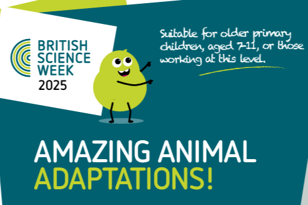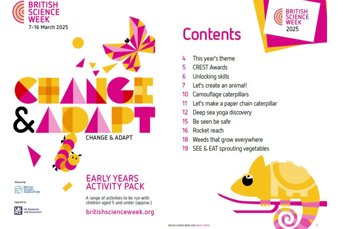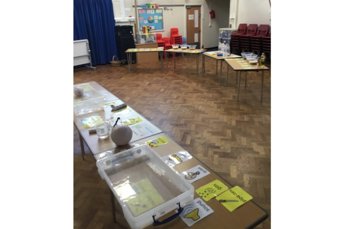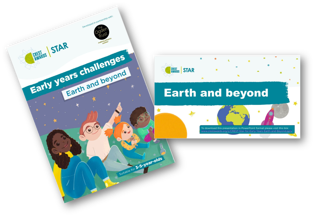Posted:
14 May 2025
Adapting resources for SEND learners

Engaging children with STEM* from a young age is a crucial part of children understanding and investigating how the world around them works & how it’s part of their everyday lives.
The British Science Association believe that science is for all young people, irrespective of their background or educational need. Children with SEND deserve a robust, equitable science education that fits their needs and abilities, and allows them to connect to their surroundings and the wider environment.
At the British Science Association (BSA), we’re keen to support teachers to provide their pupils with accessible resources and varied activities that showcase how exciting STEM can be.
Following British Science Week 2025, we spoke to Jessica Smith, a class teacher and the science coordinator at Co-op Academy Delius, and John Laughton, a teacher at Maltby Hilltop School, about how they celebrated the Week with their pupils. Jessica and John told us how they used and adapted CREST and British Science Week resources to bring science to life for children with SEND.
“They could relate the learning they do in the classroom to the activities we were doing for British Science Week”
Co-op Academy Delius caters to 2-11-year-olds with varying levels of SEND. Jessica told us about the benefits of using the Early Years (EY) and Primary British Science Week activity packs with the different pathways throughout the school.
Children at the academy are grouped into pathways that are aligned to their needs and abilities, more so than age.
To support all the teachers to get their pathways involved, Jessica chose some activities from the British Science Week activity packs and “wrote the purpose [of each activity] and which pathway it would be most suitable for, so the staff could choose from those”.
Some of the topics covered in the packs aligned with topics on the curriculum:
The EY pack was really good for us because [there were activities] to do with planting and using food, so the children could use all of the soil and the water, things they use during our continuous provision anyway. So they could really relate the learning they already do in the classroom to the activities we were doing for British Science Week.

“For them to have those things they can physically feel…it’s really important”
Jessica told us that the ‘Amazing animal adaptations!’ activity in the Primary pack, which involves matching photos of animals to cards describing how they have adapted to their environments, was particularly good for her learners, as it includes lots of visual representations.
To allow pupils to get more out of this activity Jessica and her colleagues added a sensory element:
We had things available like furry pieces of material to feel, shiny things to feel so that they could really have those physical representations of what those animals might feel like.
Teachers also provided hot water bottles and ice packs for the children to touch, and to prompt discussions about different climates. Jessica continued:
We have quite a few visual impaired learners as well, so for them to have those things they can physically feel and make it more relatable and understandable for them, it’s really important for them. The activities were great, it’s just for us as practitioners to think how can we add that extra layer in for them.
“The child could tell us what they wanted to tell us through the use of the symbols”
To help non-verbal children share what they’d learned, Jessica and her colleagues used symbols made with Boardmaker.
It’s one-word answers that the child could tell us what they wanted to tell us through the use of the symbols, even if they’re not able to verbalise.
Jessica told us the teachers at Co-op Academy Delius also used colourful semantics, a system of colour-coded word cards that helps children build sentences to ask questions and show what they’ve learned.
This is a key part of adapting resources for children with SEND, making sure there’s a two way line of communication, and giving them as much autonomy as possible to engage with the topic.
As well as using the activity packs, the school bought a chick hatching experience, funded by a British Science Week Kick Start Grant. Jessica told us it was a big success; the children loved meeting the chicks!
She explained that this activity was adapted for the children who might not cope with being in the room with the chicks by having a camera set up to livestream the action onto screens in other classrooms.
Children who did meet the chicks were able to handle them, learn about taking care of them, which Jessica said brought out a gentle side in some of the children she hadn’t seen before.

“I thought [CREST] would be great for the children and young people…to have a recognised Award for their effort and engagement”
Maltby Hilltop School is a school for pupils aged 2-19 with severe and profound and/or multiple learning difficulties. John teachers children within KS2/KS3 with profound multiple learning difficulties.
For British Science Week, John ran activities with his pupils that could be submitted for Star CREST Awards, including two from Primary Science Teaching Trust which were designed for children with SEND.
One was ‘Booming balloons’, which involves exploring the different sounds created when hitting a balloon with different materials inside. The other was ‘Pop rocket to the moon’, an activity learning about how chemicals can react with each other to build pressure.
While we have a Resource Library full of activities for children and young people working at primary level, other activities from external sources can also be submitted for Awards, as long as they fulfil certain criteria. This can be a great alternative way for children and young people in special schools to gain the pride and sense of achievement of receiving a CREST Award.
John told us:
I thought [CREST] would be great for the children and young people at Hilltop, as they would firstly hopefully have lots of fun engaging in a range of fun engaging science sessions, and secondly have a recognised Award for their effort and engagement.
CREST and British Science Week resources are flexible and many can be easily adjusted and adapted for children and young people with SEND.
The British Science Week packs are recommended for certain age groups, but we encourage educators to be flexible across the packs and use whichever activities suit their learners, modifying them where needed.
Similarly with CREST, the age ranges are just suggestions and the activities don’t have to stick rigidly to the descriptions, as long as they meet the criteria and children are having a meaningful learning experience.
In our CREST Resource Library, you’ll find a Bronze project ‘Design and make a pizza box’, developed specifically for learners with SEND, which includes a Widget vocabulary sheet, an adapted student workbook and a set of supporting classroom slides.
We’ll soon be publishing a collection of editable primary level CREST challenges, to make it easier for teachers to adjust and modify the resources for the needs of their learners.

The layout for the activities at Maltby Hilltop
“I ensured children had access to the use of Makaton symbols”
Like Jessica, John further adapted the activities to be accessible to all pupils:
I ensured children had access to the use of Makaton symbols, which were laminated on a yellow background to meet the needs of children with visual impairments.
The Makaton website describes it as “a unique communication programme that uses symbols (pictures), signs (gestures) and speech to enable people to communicate.”
John explained that the pupils, many of whom are wheelchair users, were “supported at the appropriate level by staff to help the children and young people engage in the learning on their level”.
After the success of British Science Week, John intends to run more CREST challenges in the summer term from the Star Resource Library, funded by an Engage Grant from the BSA.
By engaging children and young people in fun exciting activities this can help them to develop a love for science
Both Jessica and John talked about the importance of involving parents/carers in their children’s STEM education, and encouraging learning at home.
John told us that staff took lots of photos during the activities that could be sent home to parents/carers to hopefully inspire them.
I believe that by engaging children and young people in fun exciting activities this can help them to develop a love for science and an interest to possibly engage in science activities at home.
Jessica said parents were invited into the school to participate in British Science Week, and the activities packs were sent home so parents/carers could run them themselves, supporting them when needed.
If parents need something for the activity they don’t have at home, they can send a message and the school will send it.
“We’re constantly asking science-related questions”
Jessica and John also agree on relating science to the children’s everyday lives as way to engage them.
“We try to interweave STEM throughout all of our lessons” Jessica said, “so we are cooking, if we are gardening, we’re constantly asking science-related questions such as what does this plant need to grow?”
John shared how important it is to “develop their understanding of seeing science/maths in their play/exploration, not only within the classroom but also when out of school”.
“For our children you can make anything into something fun and relatable towards science”
One of Jessica’s final thoughts and advice to teachers in special schools is to think outside the box in terms of what science has to look like.
When we think about science, we think that everything has to be Bunsen burners and literal science experiments, but actually for our children you can make anything into something fun and relatable towards science.
John’s advice is about making sure staff are given all the information they need to deliver the activities in a way that will be the most beneficial.
I feel it is really important that prior to the activities…that the supporting members of staff understand the lesson to be taught and therefore can support children within their learning.
Both Co-op Academy Delius and Maltby Hilltop School received funding from the BSA to fund running CREST, a Kick Start Grant and an Engage Grant respectively. We encourage applications from special schools. A new round of Engage Grants will be opening later this year.
Find ten top tips from Jessica and John:
*STEM is an acronym for science, technology, engineering and maths


